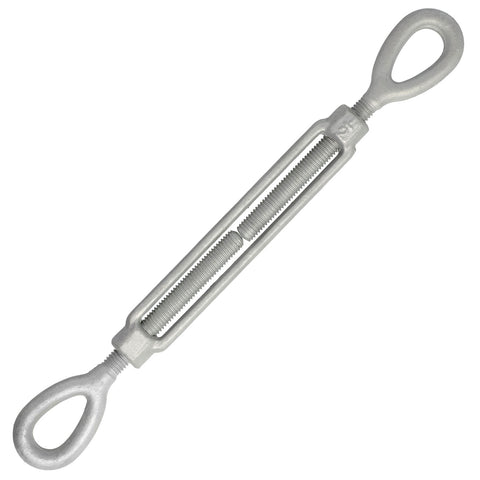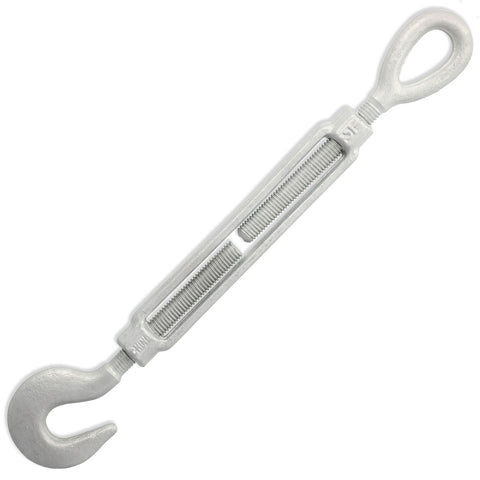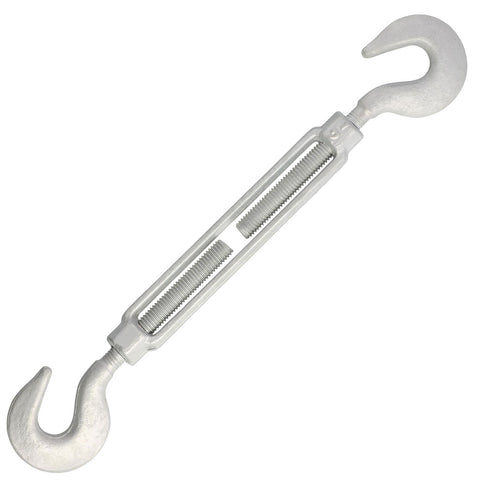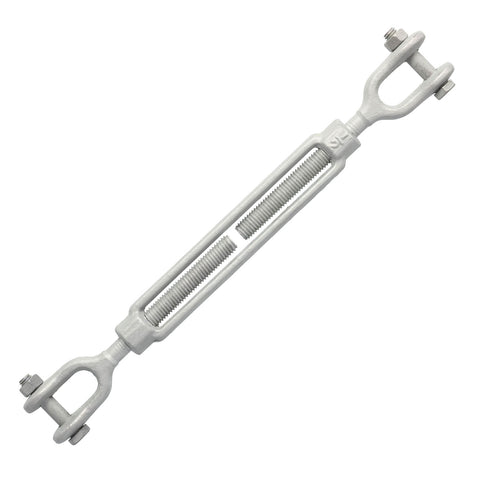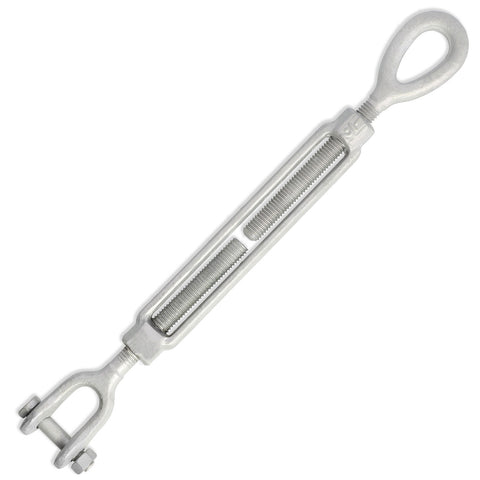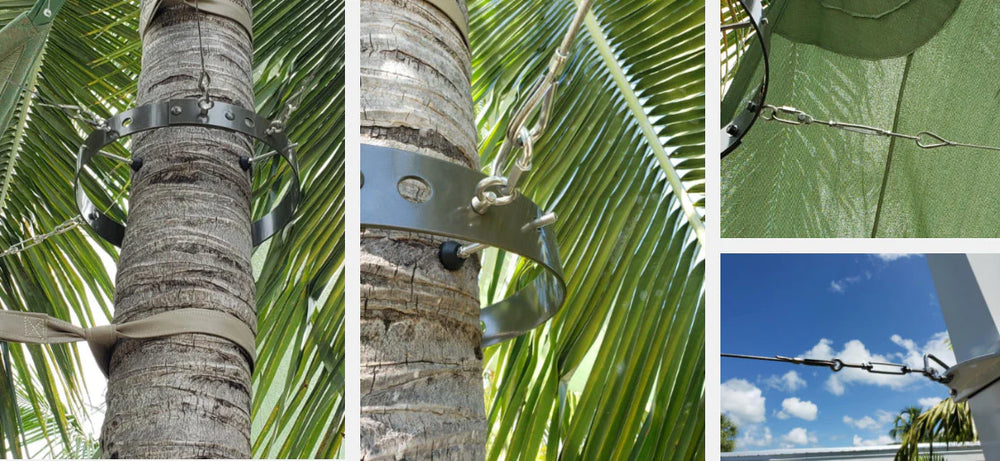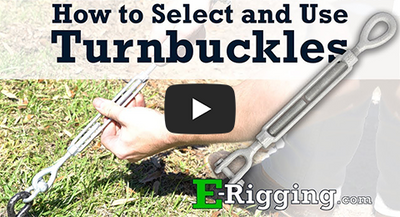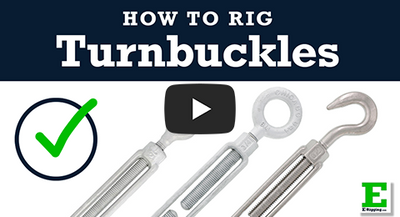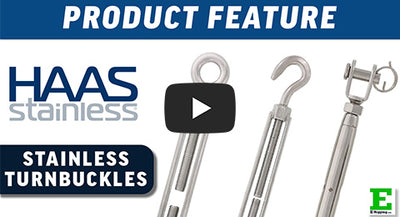
What are the different types of Turnbuckles:
Turnbuckles are essential tools for various applications, designed to take up slack and apply tension. At E-Rigging, we offer a wide range of turnbuckles, available in five basic styles:
How to select the Correct Turnbuckle End Fitting:
Turnbuckle Eye End Fittings
Turnbuckle Eye end fittings are the most durable and cost effective ends. Due to their forged permanently closed eye, they are typically used in permanent applications, or in conjunction with a shackle to connect to other fittings. If the load is removed from the eye end fittings, the eye will remain connected securely to the rigging assembly.
Turnbuckle Jaw End Fittings
Turnbuckle Jaw end fittings are versatile because they can be used in permanent and temporary applications. The pin can be removed and attached to other permanently closed end fittings like eyes formed in a wire rope, or a pad eye. The bolt and cotter supplied on some turnbuckle jaw fittings make it suitable for permanent rigging applications. If the load is removed from the jaw end fittings, the jaw will remain connected securely to the rigging assembly.
Turnbuckle Hook End Fittings
Turnbuckle Hook end fittings are perfect for quick connections on temporary rigging applications. The hook is large and durable enough to connect to many other rigging fittings. The hook end fitting type is not recommended for critical or dynamic applications. If the load is removed from the assembly, the hook end fitting may disconnect from the other fittings.
How to size a Turnbuckle for Take-up and Strength:
Turnbuckles are made up of a body and 2 end fittings. The inside length of the turnbuckle body determines the length that end fittings can screw in and out. Sizes are referred to by the thread diameter of the end fittings, then by the length that the end fittings can be screwed in and out (also known as the “take-up”). So, a ½” x 12” jaw x eye turnbuckle has end fittings with ½” diameter threads. The take-up would be 12” and one end of the turnbuckle would have a jaw end fitting and the other end would have an eye end fitting.
The larger the thread diameter of the end fitting, the more capacity the turnbuckle will have. The longer the length of the turnbuckle body, the more slack it can take-up.
How to use a Turnbuckle:
See our full guide on how to use a turnbuckle here.
Quick steps to use a turnbuckle:
- First unscrew the end fittings all the way out and take care not to screw them too far (inside the ends of the turnbuckle body).
- Then attach each end of the turnbuckle to the work pieces. Be sure that the end fittings cannot turn.
- One end fitting has left hand threads and the other has right hand threads. Turning the turnbuckle body will draw both end fittings in simultaneously and tension will be applied.
What coating or material should my Turnbuckle be made from:
Hot Dipped Galvanized
The hot dipped galvanized turnbuckles offered by E-Rigging have drop forged bodies and end fittings. As a protective finish, both the end fittings and body are hot dip galvanized. These turnbuckles are also made to conform to U.S. Federal Specification FF-T-791B.
Stainless Steel
E-Rigging also offers stainless steel turnbuckles with a variety of end fittings and turnbuckle body styles. Stainless steel turnbuckles are available with hooks, eyes, jaws and toggles and combinations of each. Traditional bodies and architectural pipe style bodied versions are offered as well. All E-Rigging stainless steel turnbuckles are made of type 316 marine grade corrosion resistant stainless steel.
See our guide on how to select a turnbuckle here. For a full picture and video explanation on the differences between materials and coatings, see our materials and coatings guide here.
Featured Blogs
Turnbuckle FAQs
Turnbuckle Eye End Fittings
- Durability: Eye end fittings are the most durable and cost-effective
- Permanent Applications: Ideal for permanent setups due to their permanently closed eye
- Secure Connection: Remain securely connected even if the load is removed
Turnbuckle Jaw End Fittings
- Versatility: Suitable for both permanent and temporary applications
- Removable Pin: Allows easy attachment to other fittings
- Secure with Bolt and Cotter: Ensures secure connections in permanent rigging applications
Turnbuckle Hook End Fittings
- Quick Connections: Best for temporary rigging applications
- Large and Durable: Easily connects to various other fittings
- Not for Critical Applications: May disconnect if the load is removed
Hot Dipped Galvanized Turnbuckles
- Construction: Drop forged bodies and end fittings
- Protective Finish: Hot dip galvanized for corrosion resistance
- Specification: Conform to US Federal Specification FF-T-791B
Stainless Steel Turnbuckles
- Variety: Available with hooks, eyes, jaws, and toggles in various combinations
- Materials: Made from type 316 marine grade corrosion-resistant stainless steel
- Styles: Includes traditional bodies and architectural pipe style bodies
For detailed instructions, see our full guide on how to use a turnbuckle. Here are the quick steps:
- Unscrew End Fittings: Unscrew them all the way out but avoid removing them completely
- Attach End Fittings: Secure each end to the work pieces ensuring they cannot turn
- Apply Tension: Turning the turnbuckle body will draw both end fittings in simultaneously, applying tension
Turnbuckles consist of a body and two end fittings The size is determined by:
- Thread Diameter: Indicates the diameter of the end fittings
- Take-Up Length: The length that end fittings can be screwed in and out
- Thread Diameter: ½”
- Take-Up Length: 12”
- Larger Thread Diameter: Higher capacity
- Longer Turnbuckle Body: Greater slack take-up
A turnbuckle is a device used to adjust the tension or length of ropes, cables, tie rods, and other tensioning systems. It consists of two threaded eyelets or hooks, one screwed into each end of a small metal frame, typically made of steel or stainless steel. Turnbuckles are commonly used in applications such as rigging, securing loads, tensioning fences, and supporting structural frameworks.
Alternatives to turnbuckles include:
- Chain Tensioners: Used for adjusting the tension in chains.
- Ratchet Straps: Provide tension adjustment for securing loads.
- Tension Clamps: Commonly used in fencing and light rigging applications.
- Wire Rope Grips:Used for securing and tensioning wire ropes without the need for turnbuckles.
To tighten a turnbuckle:
- Unscrew the End Fittings: Start by unscrewing both end fittings from the turnbuckle body.
- Attach the End Fittings: Secure each end fitting to the respective load or anchor point.
- Turn the Central Body: Rotate the turnbuckle body to draw the end fittings inward, thereby increasing tension. Ensure that one end fitting has right-hand threads and the other has left-hand threads.
- Check the Tension: Adjust until the desired tension is achieved. Ensure the fittings are secure and cannot turn.
A turnbuckle operates by rotating its central frame, which causes the two threaded end fittings to move in opposite directions. Each end fitting has opposite thread directions (one left-hand thread and one right-hand thread). By turning the central body, the end fittings either draw closer together or move further apart, thus adjusting the tension or length of the attached components.
A turnbuckle is threaded with one end fitting having right-hand threads and the other having left-hand threads. This opposite threading allows the turnbuckle to adjust tension as the central body is rotated. When you turn the body, both end fittings move simultaneously in opposite directions, either tightening or loosening the connection.
The rules and regulations for turnbuckles include adhering to OSHA standards such as regular inspections, maintaining load capacity limits, ensuring secure attachments, and using appropriate safety pins or cotter pins. Additionally, turnbuckles must conform to federal specifications like U.S. Federal Specification FF-T-791B, ensuring they meet quality and safety standards. Learn how to ensure safe and compliant rigging operations with our comprehensive guide.
